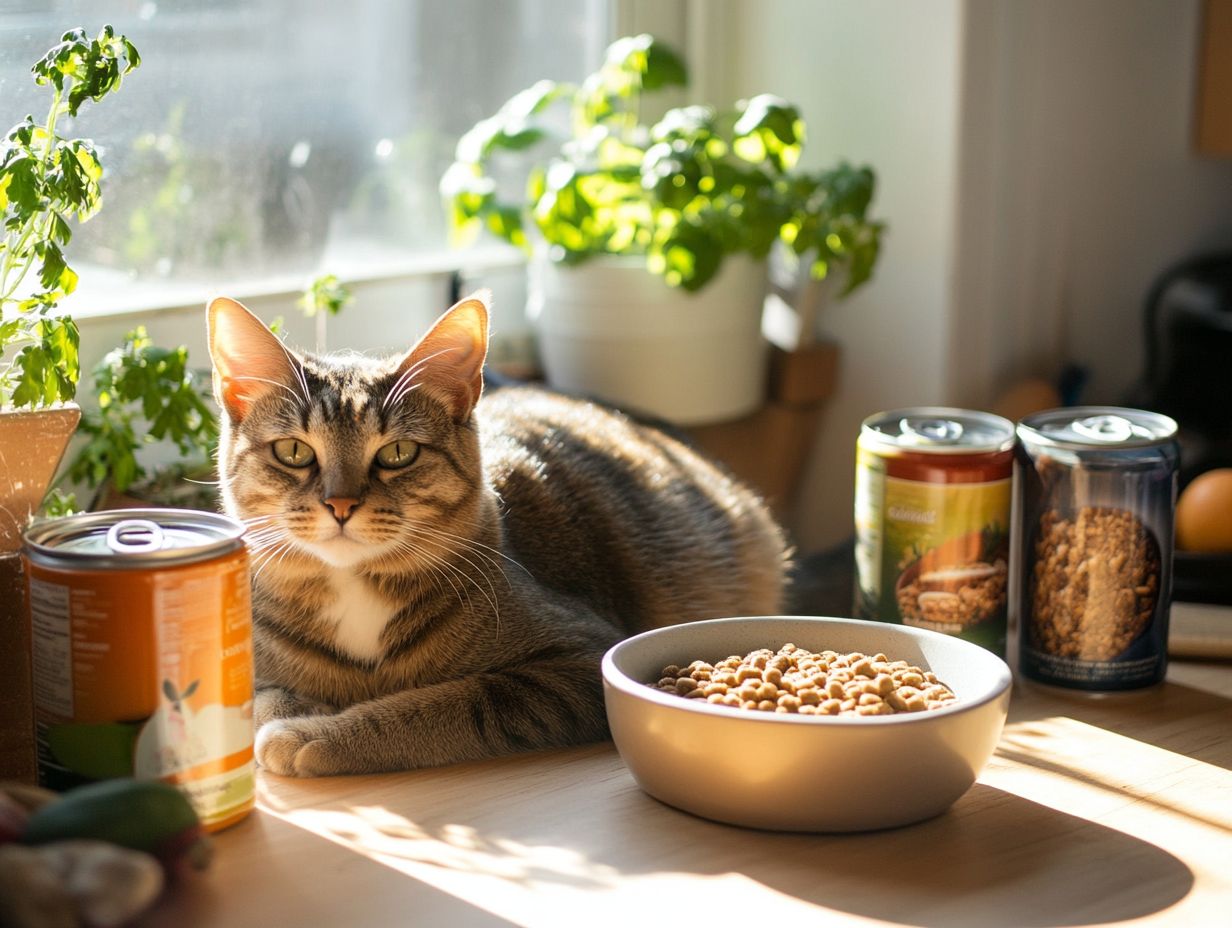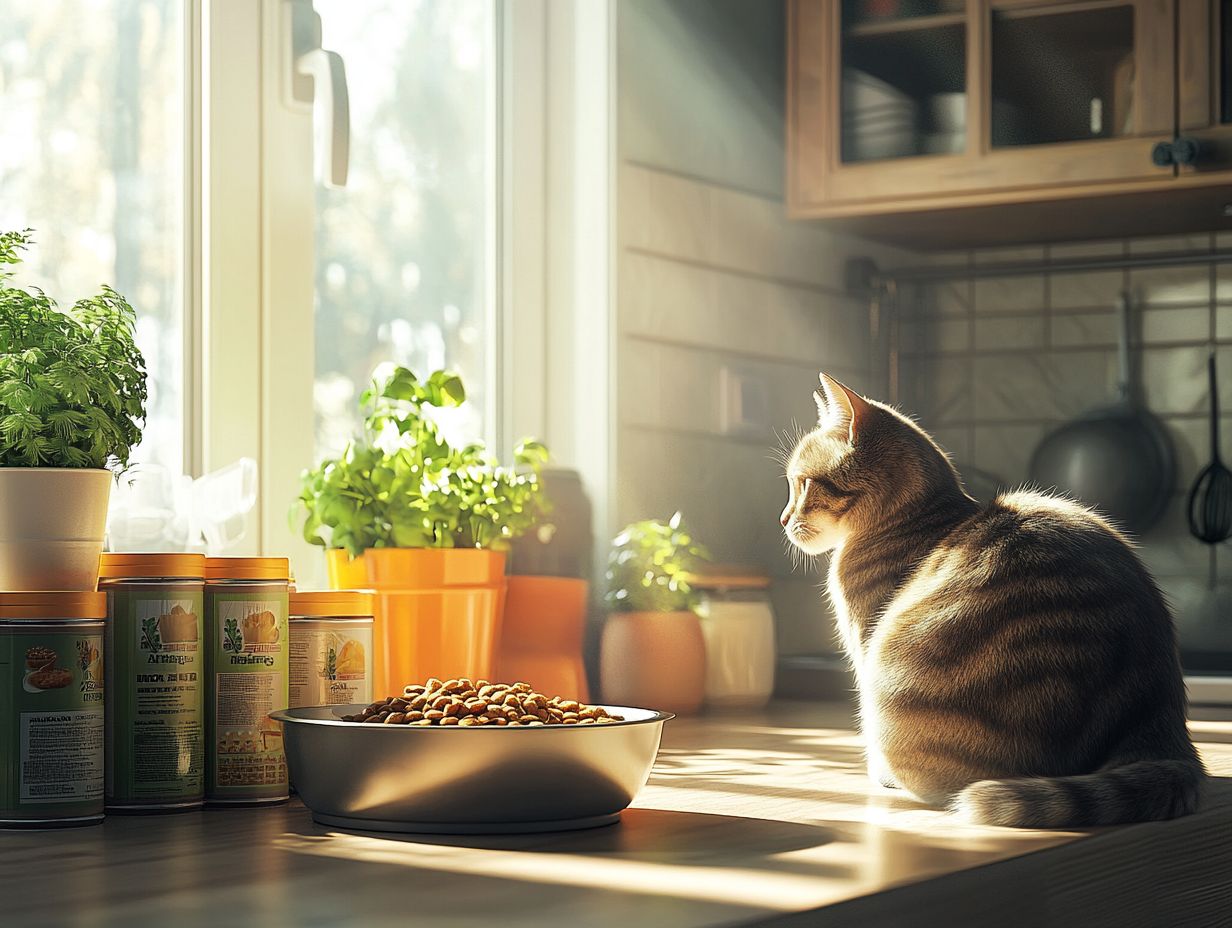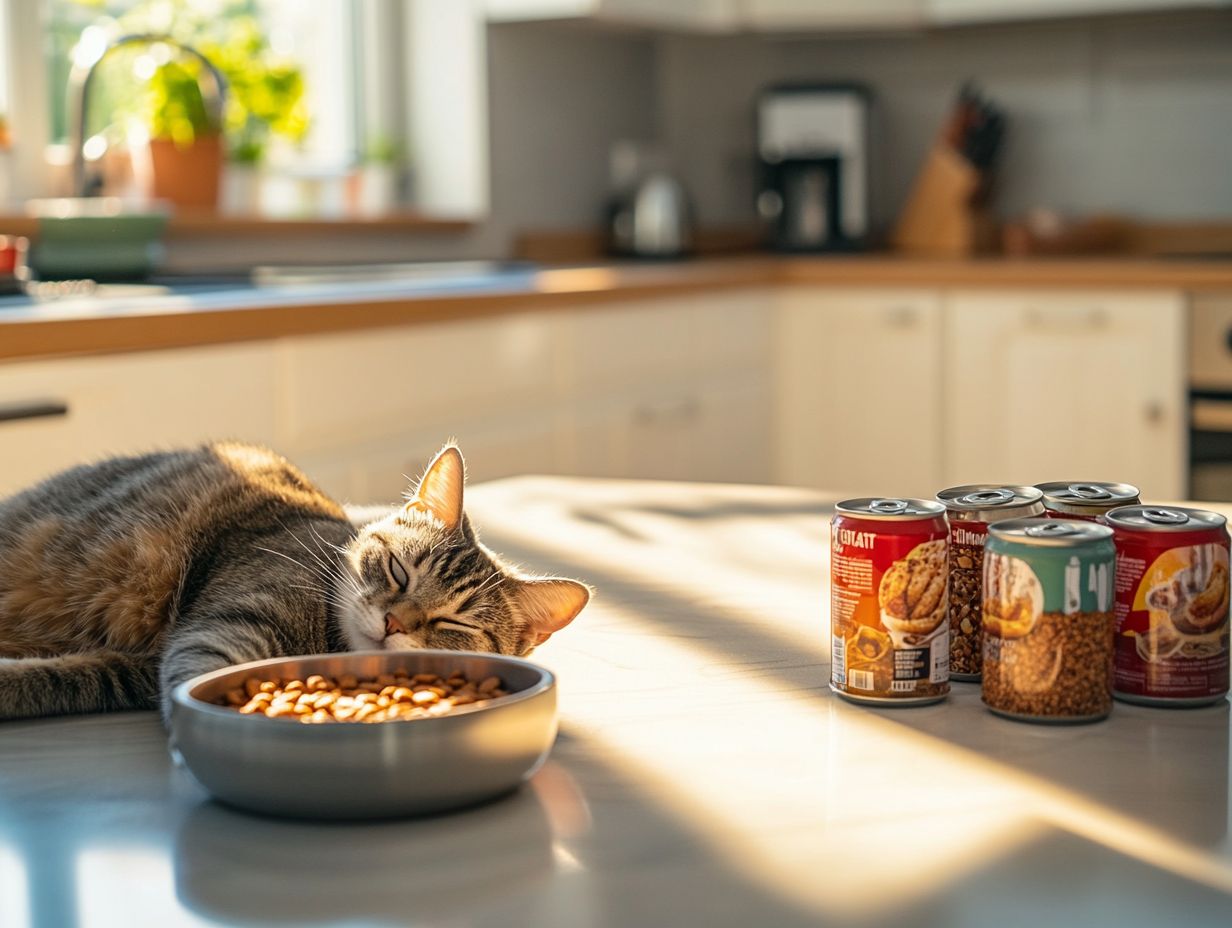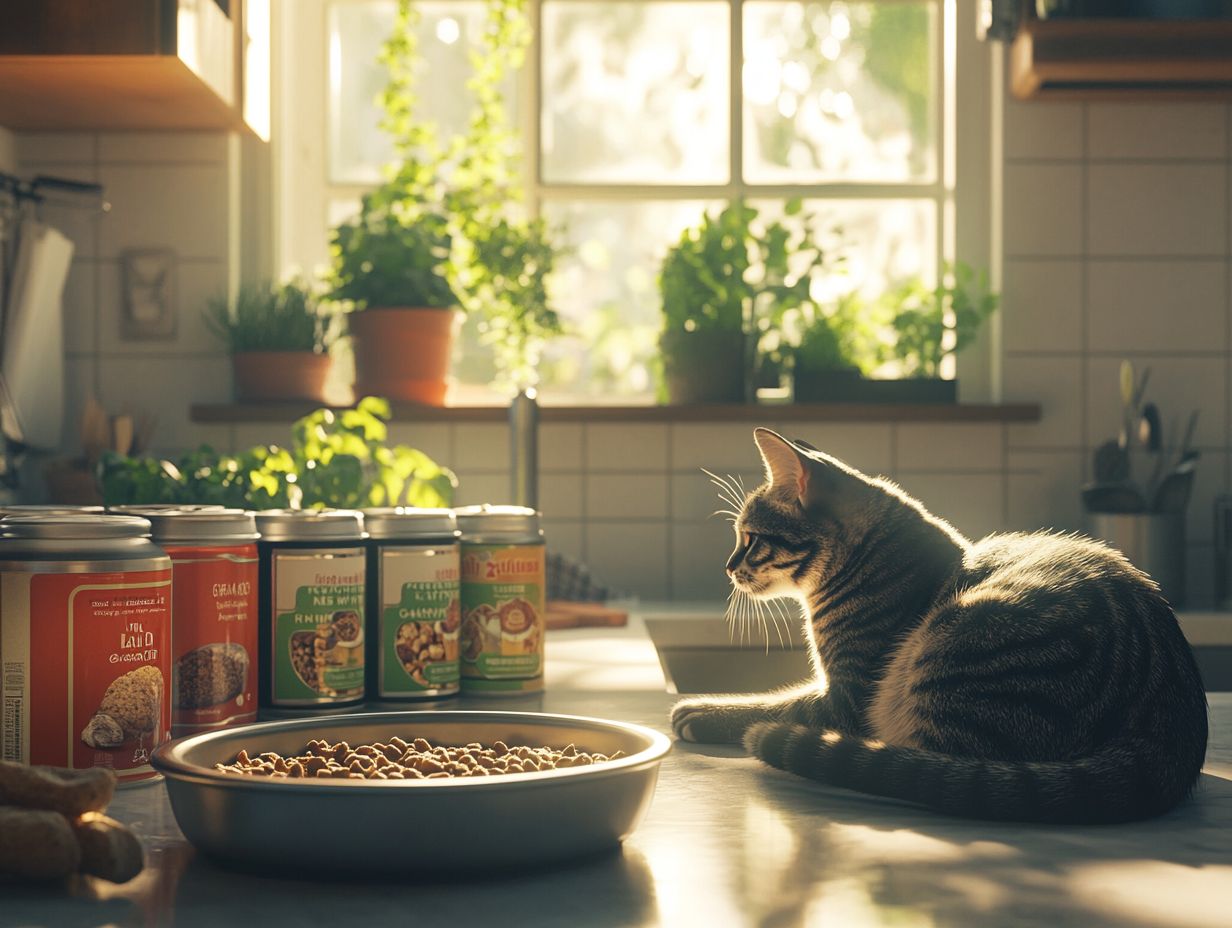Indoor cats are obligate carnivores, meaning they require a diet high in animal-source proteins to thrive. Understanding the importance of proper nutrition for these less active felines is key to ensuring their health and well-being.
This article explores indoor cat nutrition, highlights the best foods available—especially grain-free options for some cats—and offers practical advice on how much to feed your indoor cat with recommendations on the best indoor cat food choices. However, it’s vital to consult with a veterinarian, especially for those with specific health conditions or dietary needs.
From recognizing signs of nutrient deficiencies to transitioning diets, this guide provides essential knowledge to keep your indoor companion thriving.
Key Takeaways:

What is Indoor Cat Nutrition?
Indoor cat nutrition focuses on the specific dietary needs of domestic cats that spend most of their lives indoors. It encompasses all essential nutrients required to maintain proper health, including protein sources like chicken and salmon meal, omega-3 fatty acids, and fiber from various sources, while ensuring that food choices meet AAFCO nutrient profiles.
Understanding indoor cat nutrition is crucial for pet owners who want to select the best food options that promote healthy digestion and weight management, as well as prevent hairballs and obesity-related issues.
Why is Nutrition Important for Indoor Cats?
Nutrition is crucial for the overall health of indoor cats, as their more sedentary lifestyle makes them susceptible to various health issues that can be mitigated by a good diet.
Indoor cat food is specifically formulated to meet their unique nutritional needs, supporting healthy digestion, aiding in weight management, and enhancing their immune system. It’s important to choose brands that comply with AAFCO standards or have undergone feeding trials to ensure their nutritional adequacy.
Since indoor cats have limited access to natural prey, their diet must be enriched with essential vitamins and minerals to promote their health and prevent obesity and related disorders.
What are the Unique Nutritional Needs of Indoor Cats?
Indoor cats have distinct nutritional needs that differ significantly from those of outdoor cats, primarily due to their lower activity levels and lifestyle. A well-balanced diet for indoor cats should prioritize protein sources to support muscle maintenance, omega-3 fatty acids for cognitive and skin health, and adequate fiber to aid digestion and prevent hairballs. Proper weight management is crucial, as indoor cats are more prone to obesity, making it essential to balance calories and nutrients according to their sedentary lifestyle.
When selecting cat food, look for products that contain high-quality animal-based proteins, such as chicken or fish, including ocean whitefish, as these provide the essential amino acids necessary for your cat’s overall health. Incorporating moderate levels of fat ensures they receive energy without excessive calories, while dietary fibers like beet pulp can promote gut health.
It is advisable to choose brands such as Royal Canin, Hill’s Science Diet, or Blue Buffalo, which are specifically formulated for indoor cats and address their unique dietary requirements while adhering to AAFCO standards. Always opt for foods that have undergone feeding trials to ensure their nutritional adequacy.
Kittens, senior cats, and pregnant or nursing cats have unique dietary needs that differ from those of adult indoor cats. Kittens require higher protein and calorie content for growth, while senior cats may benefit from lower calories and increased fiber to maintain digestive health. Pregnant or nursing cats need a nutrient-dense diet to support both their health and that of their kittens.
What Are the Best Foods for Indoor Cats?
The best foods for indoor cats cater to their unique dietary needs, ensuring a balanced diet that promotes their overall health and well-being. High-quality brands such as Royal Canin, Purina One, and Natural Balance often offer specialized formulations designed specifically for indoor cats, while also complying with AAFCO standards.
It is important to store cat food properly to prevent spoilage. Keep food in a cool, dry place, and ensure that the packaging is sealed tightly. Signs of food spoilage include an off smell, discoloration, or the presence of mold. Discard any spoiled food immediately.
Weight management is crucial for indoor cats. Regular vet check-ups and monitoring your cat’s weight regularly can help mitigate the risks of obesity. Follow the latest guidelines on feline obesity to ensure your cat maintains a healthy weight.
Always consult your veterinarian before making significant dietary changes, especially for cats with pre-existing health issues like diabetes or kidney disease.
When recommending the best cat food for indoor cats, it is important to consider not only nutritional value but also factors like palatability and digestibility. This comprehensive approach helps owners select the most suitable indoor cat food to meet their pets’ health requirements. Given that cats are obligate carnivores, their diets should primarily consist of animal-source proteins, whether grain-inclusive or grain-free.
What are the Benefits of Grain-Free Foods for Indoor Cats?
Product Formulas: Grain-free foods provide numerous benefits for indoor cats by focusing on high-quality protein sources while excluding fillers that may contribute to unhealthy weight gain. While these specialized diets can support healthy digestion, it’s crucial to consider that not all cats benefit from grain-free formulations. Some cats may face risks of nutrient deficiencies if their diets are not well-balanced. Tips from animal nutritionists emphasize the importance of choosing options that adhere to AAFCO and WSAVA guidelines for optimal nutrition.
Weight Management: A grain-free diet can assist in weight management by promoting lean body mass and healthier metabolic rates, which are essential for cats predisposed to obesity. This emphasis on protein also helps preserve muscle, contributing to improved strength and agility. For indoor cats with health issues such as obesity or diabetes, tailored dietary plans should be created in consultation with veterinary professionals.
Owner Observations: Many pet owners have observed improvements in coat quality and increased vitality in their cats after switching to grain-free options. Popular brands such as Wellness CORE, Blue Buffalo Wilderness, and Taste of the Wild offer high-quality grain-free selections. However, it’s important to consult with a veterinary nutritionist, like Dr. Jamie Richardson, to make informed choices that ensure the overall well-being of their furry companions.
What Other Nutritional Considerations Should Be Taken for Indoor Cats?

Along with selecting the best brand of indoor cat food, such as those recommended by the WSAVA and experts like Dr. Deb Zoran, pet owners must consider other nutritional factors. A balanced diet should include both wet and dry cat food options to promote healthy digestion and proper hydration, while also catering to an individual cat’s health needs, age, and activity levels.
Consulting with veterinary nutritionists can provide valuable guidance on which cat food brands are most suitable. A balanced diet is particularly important for indoor cats, who typically lead a more sedentary lifestyle. Dry cat food helps maintain optimal dental health by reducing tartar buildup, while wet cat food contributes to hydration and often contains higher protein levels, which are essential for maintaining muscle health.
Additionally, factors such as weight management and specific health issues related to indoor cats, such as obesity and urinary tract problems, should also be considered. Veterinary professionals can assist in creating a tailored diet plan that meets the unique needs of each indoor cat. It’s vital to assess dietary choices with a professional to mitigate risks associated with homemade or raw diets.
How Much Should I Feed My Indoor Cat?
Understanding how much to feed indoor cats is essential for promoting a healthy weight and meeting their specific nutrition needs. The required amount of food varies based on factors such as age, weight, activity level, and overall health. Collaborating with veterinary nutritionists, such as those from Small Door Vet and Texas A&M University, to establish appropriate portion sizes and feeding schedules can help cat owners effectively manage their pets’ weight while ensuring they receive adequate nutrition for optimal health. Additionally, factors such as breed and pre-existing medical conditions may necessitate specialty diets.
Establishing a feeding schedule provides a structured routine that aids owners in monitoring their indoor cat’s food intake. Regular feeding times can enhance digestion and prevent behavioral issues that may arise from hunger or overactivity. Tools like measuring cups and pre-packaged containers can assist owners in maintaining the correct serving sizes for their indoor cats. Proper food storage practices and monitoring for spoilage are also essential for maintaining food safety.
What Are the Signs of a Nutrient Deficient Diet in Indoor Cats?
Symptoms indicating that an indoor cat may be on a nutrient-deficient diet over time include the following:
- Weight Changes: Sudden weight loss or gain can signal an underlying illness, such as diabetes or cancer, or insufficient calorie intake. Proper weight management is crucial for a cat’s health.
- Coat Condition: A healthy cat’s coat is shiny, soft, and smooth. A dull coat or excessive shedding can indicate poor health and nutrient deficiencies.
- Oral Health: Nutrient deficiencies in calcium, phosphorus, vitamin D, and vitamin C can exacerbate dental disease or gingivitis. Consulting with an animal nutritionist can help prevent these issues.
- Behavior Changes: Changes in behavior may indicate an underlying health issue, potentially linked to a nutrient-deficient diet.
- Sneezing or Coughing: If a cat is sneezing or coughing, it may indicate an upper respiratory infection, which can worsen due to a weakened immune system.
- Gastrointestinal Issues: Excessive diarrhea, vomiting, or constipation may point to gastrointestinal infections or illnesses related to nutrient deficiencies.
- Seizures: Seizures are typically associated with underlying neurological diseases or injuries, which can be aggravated by nutrient deficiencies.
- Frequent UTIs: Frequent urinary tract infections may signal urinary obstruction, potentially caused by nutrient deficiencies.
Nutritionally induced illnesses can develop if a cat is maintained on a suboptimal diet for an extended period. The effects of nutrient deficiencies—such as weakened bone structure and impaired immune function—can be irreversible. Cats are obligate carnivores and require animal-source proteins for optimal health, so it is essential to meet their nutrition needs over time. Regular veterinary visits are essential for detecting deficiencies and adjusting diets as needed.
By making informed nutritional choices and frequently adjusting a cat’s diet with professional guidance, owners can ensure their pets’ health and prevent these issues from worsening.
What Are the Risks of Feeding My Indoor Cat a Poor Diet?
The dangers of a poor diet for indoor cats pose significant risks to their health and quality of life. Inadequate nutrition can lead to obesity, digestive issues, and weakened immune systems, all of which can result in serious health problems. Consulting veterinary nutritionists can provide valuable insights. It is crucial for indoor cat food to be properly balanced to meet their nutritional needs, as this is essential for effective weight management and overall health. Owners must remain vigilant, as studies indicate that nearly 60% of indoor pet cats are overweight or obese.
This condition increases the likelihood of developing diabetes, arthritis, and even certain types of cancer by as much as 300%. Short-term effects may manifest as lethargy or poor grooming habits, while long-term consequences can include chronic diseases that require expensive treatments.
Providing a proper diet can help mitigate these risks. Additionally, regular veterinary visits and physical activity are important for ensuring the overall health of indoor cats, further reducing the dangers associated with poor nutrition.
How Can I Transition My Indoor Cat to a Grain-Free Diet?
Transitioning your indoor cat to a grain-free diet can be a straightforward process if approached gradually and with careful planning. Begin by mixing the new grain-free cat food with their current food, gradually increasing the proportion of the new diet while decreasing the old. Monitoring your cat’s response during this transition is essential, as some cats may have specific nutritional needs that require tailored adjustments. Consulting with a veterinarian can provide additional guidance.
Start this process over one to two weeks to allow your cat’s digestive system to adapt to the new ingredients. Each day, observe any changes in behavior or stool consistency, watching for signs of digestive upset, such as diarrhea or vomiting. If any adverse reactions occur, slow down the transition or revert to the previous food temporarily. Patience is crucial; rushing the switch can lead to discomfort.
Additionally, consider incorporating a variety of protein sources into the grain-free diet to ensure your cat receives a balanced intake of nutrients, which can enhance their overall health and vitality. Note that while grain-free diets can be beneficial, they must be nutritionally adequate. Potential risks, such as dilated cardiomyopathy (DCM), should be discussed with your veterinarian.
What Are Some Recommended Grain-Free Foods for Indoor Cats?
When selecting grain-free foods, consider your cat’s specific life stage. Kittens, senior cats, and pregnant or nursing cats have unique nutritional requirements. Always consult your veterinarian before making significant dietary changes, especially for cats with existing health conditions.
Proper food storage and handling are essential for maintaining nutrition. Store commercial and homemade diets in a cool, dry place, and check for spoilage regularly. Look for signs such as an off smell, mold, or changes in texture.
Be cautious about feeding homemade raw diets without veterinary guidance, as this can pose serious health risks. Discuss the need for supplements with your vet, including appropriate dosages and their safety.
Indoor cats can receive proper nutrition from a diverse range of high-quality diets. Recommended cat food brands for indoor cats include:
- Merrick Purrfect Bistro
- Royal Canin
- Purina One
- Wellness CORE
- Blue Buffalo Wilderness
- Instinct by Nature’s Variety
- Ziwi Peak
For more information on suitable diets for indoor cats, check out Indoor Cat Nutrition: Top Grain-Free Foods for Less Active Felines.
These brands focus on providing high protein, healthy essential fatty acids, and promoting good digestion. Additionally, these food options cater specifically to the unique dietary needs of indoor cats, helping with hairball management and complete nutrition.
1. Merrick Purrfect Bistro Indoor Recipe

Merrick Purrfect Bistro Indoor Recipe is a high-quality dry food specifically designed for indoor cats. It is rich in animal-based protein sources and provides essential nutrients to promote healthy digestion, support weight management, and enhance overall health.
This recipe features a combination of real chicken and other ingredients that supply essential amino acids, helping to maintain muscle mass and keep cats active and healthy. Carefully crafted without grains, it is an excellent choice for cats with dietary sensitivities.
Additionally, it is packed with antioxidants and vitamins that boost the immune system and promote a healthy coat and skin. The balanced fatty acids in this formula provide the energy indoor cats need, making mealtime enjoyable for those who are more sedentary.
2. Wellness CORE Indoor Formula
Wellness CORE Indoor Formula offers a balanced, high-protein diet specifically designed to meet the unique needs of indoor cats. This formula promotes healthy digestion and helps maintain a healthy weight.
The inclusion of premium animal protein sources, such as turkey and chicken, supports the development of lean muscle and provides the energy necessary for active indoor lifestyles. Additionally, essential fatty acids are incorporated to promote a shiny coat and healthy skin.
Ingredients like lentils and peas contribute fiber, which further enhances digestive health and ensures proper nutrient absorption. Furthermore, the addition of probiotics makes this formula beneficial for cats with digestive issues.
It is important to note that while these diets are formulated to be complete, additional supplements should only be used under veterinary guidance to avoid toxicity or imbalance. Overall, these components not only meet nutritional requirements but also provide indoor cats with increased vitality and well-being. It is advisable to follow cat food recommendations by experts like Dr. Jamie Richardson or Ellen Dierenfeld.
3. Blue Buffalo Wilderness Indoor Chicken Recipe
Blue Buffalo Wilderness Indoor Chicken Recipe is a nutrient-rich formula designed specifically for indoor cats, providing essential animal protein sources while excluding grains. This food supports muscle maintenance and overall cat health.
Featuring real chicken as its primary ingredient, it ensures that your furry companions receive high-quality protein necessary for energy and muscle development. The recipe also includes wholesome fruits and vegetables, contributing essential vitamins and antioxidants that help strengthen the immune system.
Since indoor cats are often less active than their outdoor counterparts, the added fiber in this formula aids digestion and helps maintain a healthy weight. Additionally, the formulation contains omega fatty acids, promoting a shiny coat and healthy skin.
Overall, this recipe is a well-rounded choice for indoor cat owners looking for a balanced and appealing diet for their feline friends. It is recognized by AAFCO standards for complete nutrition.
4. Instinct by Nature’s Variety Indoor Recipe
Instinct by Nature’s Variety Indoor Recipe is crafted with real meat and wholesome ingredients to provide essential nutrition for indoor cats. This high-protein formula emphasizes animal-based protein sources, supporting overall health and digestion.
As with all dietary choices, it’s crucial to consult a veterinarian before making significant changes, especially for cats with specific health conditions like kidney disease or diabetes. Proper food storage and handling are also vital; always keep pet food in a cool, dry place and check for spoilage before feeding.
Each ingredient is carefully selected for its quality and nutritional value, ensuring that indoor cats receive a balanced diet formulated to meet AAFCO nutrient profiles for indoor cats. The formulation is designed not only to meet a cat’s biological needs but also to promote a healthy coat and optimal weight management.
With no fillers or artificial additives, pet owners can be confident that they are providing food that adheres to WSAVA guidelines for their indoor cats’ unique needs and lifestyle. Additionally, it includes vital omega-3 fatty acids for cats’ health, which have been shown to support overall wellness.
5. Ziwi Peak Grain-Free Canned Cat Food
Ziwi Peak Grain-Free Canned Cat Food offers a delicious and nutritious option for indoor cats, focusing on high-quality, natural ingredients that adhere to AAFCO guidelines, without any grains. This wet cat food is specifically formulated to promote healthy digestion and overall well-being in cats.
It features premium meats sourced from ethical farms, including organ meats and seafood, which provide the essential amino acids that cats require. This gourmet blend is enhanced with superfoods such as green mussels, which have been shown in studies to support joint health—a significant benefit for indoor cats that rely on play and activities for exercise. Adding DHA from Ocean Whitefish and Salmon Meal enhances the nutritional profile.
Additionally, its high moisture content helps maintain optimal hydration levels, supporting urinary tract health. Rich in Omega-3 and Omega-6 fatty acids, crucial for healthy digestion and hairball prevention, this food contributes to a glossy coat and healthy skin, addressing the lack of exercise and outdoor exposure that indoor cats often experience.
Frequently Asked Questions
What is indoor cat nutrition and why consult a veterinary nutritionist?

Indoor cat nutrition refers to the dietary needs of cats who primarily live and eat indoors. These cats tend to be less active than outdoor cats and may have different nutritional requirements. Consulting with veterinary nutritionists can help tailor these nutrition needs effectively and address any potential deficiencies.
Why should I consider grain-free food and AAFCO nutrient standards for my indoor cat?
Grain-free food may be a better option for indoor cats because they tend to have a lower activity level and may not burn off excess carbohydrates found in grains. These excess carbs can lead to weight gain and other health issues. Ensuring the food meets AAFCO nutrient standards is essential for nutritional adequacy.
What are the top grain-free foods for less active felines, including protein sources like Chicken and Ocean Whitefish?
Some top grain-free food options for less active indoor cats include Wellness CORE Natural Grain-Free Dry Cat Food, Blue Buffalo Wilderness Indoor Chicken Recipe Grain-Free Dry Cat Food, and Purina Beyond Simply Grain-Free Indoor Cat Food. These options often feature protein sources like Chicken, Salmon Meal, and Ocean Whitefish.
Are there any benefits to feeding my indoor cat grain-free food, and how does it aid in weight management?
Yes, there are several potential benefits to feeding your indoor cat a grain-free diet, including improved digestion, increased energy, healthier skin and coat, and effective weight management. However, it is important to consult a veterinarian to ensure that the diet does not lead to nutritional deficiencies or health concerns.
Can I mix grain-free food with my cat’s current diet using wet and dry cat food recommendations?
If you are planning to switch your indoor cat to a grain-free diet, it is recommended to do so gradually to avoid digestive upset. You can mix small amounts of the new food with their current diet, using both wet and dry cat food, and gradually increase the amount of grain-free food over the course of a week or two. Consider cat food recommendations from experts like Dr. Jamie Richardson.
How do I know if grain-free food, approved by Dr. Deb Zoran from Texas A&M University, is right for my indoor cat?
Ultimately, the best food for your indoor cat will depend on their individual nutritional needs and preferences. It is always a good idea to consult with your veterinarian before making any significant changes to your cat’s diet. Experts like Dr. Deb Zoran from Texas A&M University can offer valuable insights into holistic food choices and cats’ health.
How should I safely store and handle cat food?
To maintain food quality and safety, store cat food in a cool, dry place and use airtight containers. Check for signs of spoilage such as off odors or changes in texture, and discard any food that appears compromised.
What dietary adjustments should I consider for various life stages of cats?
Kittens, pregnant or nursing cats, and senior cats have unique nutritional needs. Consult your veterinarian for specific dietary recommendations suitable to your cat’s life stage to ensure they receive optimal nutrition.